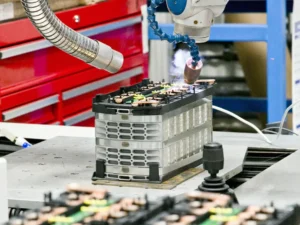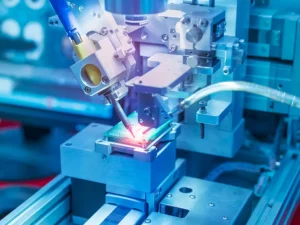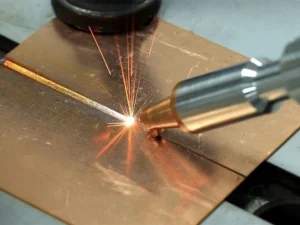Introduction:
Laser welding is an advanced high-energy beam welding technology. It has high heat source energy density, fast welding speed, and small welding deformation. The welding process is easy to achieve integration, automation, and flexibility.
Laser welding machines are widely used in industrial processing and gradually replace traditional welding methods. So, what is laser welding used for?
What is Laser Welding Used For?
At present, laser welding technology has been widely used in various fields of industry.
1. New Energy Battery

It can be applied to square, cylindrical, soft-pack battery cell connections and shell packaging welding. The power battery pack is disassembled by using a laser marking machine.
2. Home Appliance Hardware
It is widely used in aluminum, stainless steel, iron, metal, plastic, and other materials. It is mainly used in washing machines, refrigerators, air conditioners, and other home appliance hardware industries.
3. Automobile Industry

Laser technology can be used for laser cutting and welding of parts in the automotive industry. Such as automobile dials, valves, piston rings, cylinder gaskets, exhaust pipes, filters, automobile airbag generators, etc.
4. Electronic Equipment

Laser processing is a non-contact processing method that does not produce mechanical extrusion. It is particularly suitable for processing in the electronics industry, such as laser welding and laser marking of transformers, fiber optic connectors, sensors, switches, etc.
5. Jewelry Industry
Jewelry laser welding machines are mainly used for hole filling, spot welding of holes, and repair welding of gold and silver jewelry.
6. Mold Industry
Due to its fineness and small impact on materials, laser welding suits mold and high-precision machinery manufacturing industries. Such as precision repair of plastic molds, rubber molds, stamping molds, casting molds, forging molds, and wire drawing die.
Advantages of laser welding

1. Wide range of applications
It has been widely used in automobile, steel, aerospace, electronics, chemical, machinery, and other industries. Compared with traditional welding, laser welding can weld materials and products such as stainless steel, aluminum alloys, digital products, etc.
2. High energy density
The focal spot diameter is very small after the high-power laser beam is focused. The power density is high, up to 105 – 108 W/cm2, which is several orders of magnitude higher than arc welding. It can weld high hardness, high brittleness, high melting point, and high strength material.
3. High welding quality
A larger welding depth can be obtained through the small hole effect during welding. The welding seam has a dense structure and high strength.
4. Small material deformation
Laser welding has extremely high heating and cooling speeds. Its crystallization speed is dozens of times higher than that of general fusion welding. The heat-affected zone is tiny, the material deformation is small, and no subsequent processing is required.
5. Dissimilar materials can be welded
It can weld dissimilar or the same metal materials with high melting points, high thermal conductivity, and large differences in physical properties.
6. Non-contact processing
There are no problems such as tool loss and tool replacement, saving energy, and no pollution.
7. Flexible welding methods
The laser beam is easy to guide and can be transformed in various directions. The energy of the laser beam can be precisely controlled. And the moving speed is adjustable. Combined with CAD/CAM or robots, it can form a multi-functional laser processing system with fast welding speed, high efficiency, and easy automation.
The Development of Laser Welding Technologies
With the advancement of the times, laser welding technology is also constantly developing. The following technologies will help expand the application scope and improve the automatic control level.
1. Filling wire laser welding
Laser welding generally does not fill the welding wire. The assembly gap of the weldment is very high, which is sometimes difficult to guarantee in actual production. Using filler wire laser welding can greatly reduce the assembly gap requirements. For example, if no filler wire is used for an aluminum alloy plate with a thickness of 2mm, the gap between the plates must be zero to obtain good forming.
2. Beam rotation laser welding
Rotating the laser beam for welding can also significantly reduce the weldment assembly and beam-centering requirements. For example, when 2mm thick high-strength alloy steel plates are butt-jointed, the gap between seams is allowed to increase from 0.14mm to 0.25mm, while for 4 mm-thick plates, the gap is allowed to increase from 0.23mm to 0.30mm. The allowable error in the alignment of the beam center and the weld center is increased from 0.25mm to 0.5mm.
3. Laser welding quality online detection and control
The use of plasma light, sound, and charge signals to detect the laser welding process has recently become a hot research topic at home and abroad. A few research results have reached the level of closed-loop control.
Conclusion:
With its high-energy beam-focusing method, laser welding can achieve deep penetration and rapid welding. These are difficult to achieve in other welding processes during the welding process. The practice has proved that laser welding has a wide range of applications in the processing industry.
